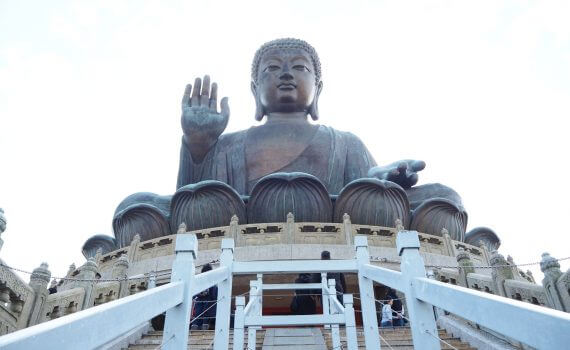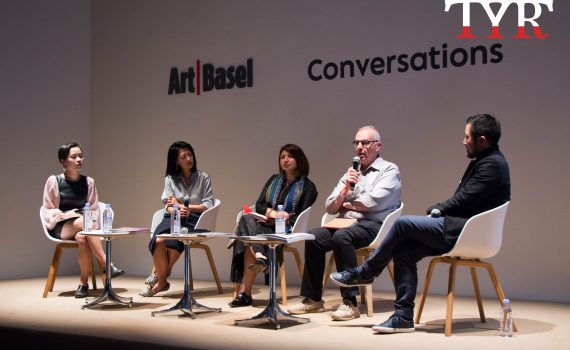Culture & Leisure
Weekend Review: Post 90s woman writes to break social stigma
- 2019-03-19
- Society
- The Young Reporter
- By: Amy Ho、Cara LiEdited by: Nadia Lam
- 2019-03-19
Comprised of stories shared by 29 individuals from the post 90s, Choy Po-yin talked about her book, Salt To The Sea: Interviews of The Post 90s’ Generation, in a sharing event organised by the Art and Culture Outreach in Lok Sin Tong Wong Chung Ming Secondary last Saturday. "Apart from writing a novel, I hold talks to discuss the topic [labelling the post 90s in society] with the public to change people's perception of the post 90s" explained to Choy Po-yin, writer of the book, Salt To The Sea: Interviews of The Post 90s" Generation. "I can feel that I [as part of the post 90s] carry a lot of labels, so I want to clear all of them," she said. There is a phenomenon in society that the post 90s, who value their opinions and embrace diversity, "are always on the frontline," she added. More people [those of the post 90s] has already met their basic living needs, so they turned to focus on other concerns, said Jacob, born in 1992 and was reluctant to reveal their full name, said. "The post 90's may be satisfied with their material lives but it does not fulfill their spiritual desires, so they are stepping up to pursue something more valuable, such as equality and justice," said Kilo, another interviewee born in 1994. Author Ms. Choy said various banners seen in Hong Kong's large-scale socio-political movements on issues including climate change and civic engagement have been demonstrating a society they [the post 90s] desire.
An old inventor of bamboo steamers
- 2019-03-02
- Photo Essay
- The Young Reporter
- By: Vanessa YungEdited by: Amy Ho
- 2019-03-02
Have you ever wondered how a bamboo steam basket filled with dim sum was made? Rounding three bamboo strips, interlocking each of them with a tool, placing a round-shaped bamboo plate in the middle as a base and attaching each part firmly under a "big stapler" machine, an old man has been repeating this process since he was a little boy.
Funded mobile van promotes family reading time in Kowloon Art Festival
- 2019-02-26
- Culture & Leisure
- The Young Reporter
- By: Hailey Man、Fang-Yi ChenEdited by: Vanessa Yung、Amy Ho
- 2019-02-26
A van parked at the end of the corner while people were strolling down the street of booths in the West Kowloon Cultural District. Unlike other common food trucks, this van was hanging around and selling books. "Nine books about Kowloon City," the banner hanging on the van said. This unique van is owned by Rolling Books, a project aims to encourage reading culture to children living in Hong Kong's remote areas, especially to those in underprivileged families. Rolling Books has been funded by the SIE Fund HK since last year. The Social Innovation and Entrepreneurship Development Fund (SIE Fund) aims "to create social impact through innovative solutions that address poverty and social exclusion and seeks to foster the well-being and cohesion of society," the government said in an online press release released in mid-January. "A stationary bookstore is too passive for promoting reading culture while a mobile van carrying books around can actively bring the fun of reading to different places and connecting with different people," said Mr. James Chong, the founder of Rolling Books. As a previous owner of an upstairs bookstore which selling mainly art and humanity books, Mr. Chong wants to promote literary and artistic culture through the project even it is particularly focus on children books. Rolling Books was invited to introduce books about the old district during the Kowloon City Art Festival this year. Mr. Chong selected nine books specifically to illustrate the landscape and history of Kowloon City in Hong Kong and match the theme. "There are a lot of books here that are not usually found in mainstream bookshops," Mr. Chan Nan, a customer looking for books by the van, said. She suggested it was good to recommend books with a theme of old Kowloon City, By orienting book recommendations for public …
Notorious housing issue introduced into children's book
- 2019-02-17
- Culture & Leisure
- The Young Reporter
- By: Sammi ChanEdited by: Alexandra Lin
- 2019-02-17
While the notorious housing condition for the poor has been the top concern of many from the working class in Hong Kong, Janas Lau Pui, a local artist specializing in children’s book and graphic novels, decided to make it a relevant topic to children by creating an illustration book. "Usually, the stories for children are about daily activities like going to the salon or going to the zoo but I want to use it as a tool to communicate with children about social issues," said Ms. Lau. Born and raised in Hong Kong in the 80s, Ms. Lau once experienced living in a cramped flat, a 300-feet space with nine family members and a double deck bed. "I wonder why the living condition nowadays is even worse than I had 30 years ago, so I want to produce a piece and raise people’s awareness about it," she said. Named as "Where is my next home?", an exhibition for the book is now held inside a nostalgic Cantonese dessert store in The Mills, an industrial place that has been revitalized into a cultural complex consisting of retail shops, co-working spaces and start-up hubs. Having been published in countries like UK and Australia, Lau's illustration book has an international readership. She recalled that a 9-year-old reader from Australia once asked why the rooftops of the buildings in Sham Shui Po were so shabby in her book. Ms. Lau told him to go and observe the buildings in that area and explore the reasons behind it. Ms. Lau thinks that it is hard to explain or watch news programmes with children, so it would be easier to open topics about social issues by using a children’s book. "I think this topic is too advanced for my four-year-old boy, which he can't really relate …
Discovering the city of Lijiang through taste
- 2019-02-11
- Photo Essay
- The Young Reporter
- By: Katherine Li、Fang-Yi ChenEdited by: Wallis Wang
- 2019-02-11
Northwest in Yunnan Province in China, Lijiang is a city rich culture. Its Old Town area has more than 800 years of history which played a crucial role during the ancient Silk Road. Craig Au-Yeung, show host and food columnist, along with his wife Millie Wong, showcase their travel experiences in Lijiang and demonstrates an uncomplicated but hearty Yunnan home dish — Stewed Potatoes and Rice — for the participating food enthusiasts. This workshop took place in the Taste Library on the fifth floor of PMQ in Central, a 2000 square-foot space which encourages culinary explorations through the form of literature with books from around the globe.
Chinese New Year speciality: Fish-shaped rice cakes
- 2019-02-04
- Photo Essay
- The Young Reporter
- By: Anna Kam、Nadia LamEdited by: Katherine Li、Anna Kam、Nadia Lam
- 2019-02-04
Following two families creating beautiful rice cakes in the form of fish at PMQ. During the Lunar New Year, the fishes symbolise having financial surplus while the rice cakes symbolise that children with grow taller and also do better in the coming year. Two families with two lovely girls prepare to start their craft with the help of Cordon Bleu graduate, Andy Dark, who teaches them how to create beautiful rice cakes.
Gaudí's Barcelona
- 2018-06-09
- Photo Essay
- The Young Reporter
- By: Sharon Pun、Oasis LiEdited by: Holly Chik
- 2018-06-09
Sagrada Família is kind of hard to miss in Barcelona, not only because of its height and size, but it is unusual to see a seemingly old building constantly surrounded by construction cranes. On the day of visit, tourists craned their necks to gawk at the spire, some with the ice-cream they just bought from one of the mant vendors dripping down their front as they gawked at the spires. Other posed as the crucified Christ outside the main doors. Unlike most crucifixes, the Jesus figure on this one stares down at an angle, almost as if he is flying. Such unconventional and sometimes over decorated designs are iconic of the Catalan architect, Antoni Gaudí (1852-1926). His work defines Catalan Modernism. Between 1984 to 2005, seven of his masterpieces were listed as World Heritage Sites by UNESCO, including Casa Batlló, Park Güell and the unfinished basilica, Sagrada Família. More than six million tourists visited Spain in April, according to the country’s government data, and Sagrada Família alone drew more than three million people. A survey by Statista indicates that other masterpieces by Gaudí, including Park Guell, La Pedrera and Casa Batlló also rank among the top destinations. In 1877, Gaudí designed his first building, Casa Vicens, under the commission of a merchant Manuel Vicens, on Passeig de Gràcia, Barcelona. Further down the boulevard stands Casa Batlló with its colourful mosaic and dragon-like balconies. The line for tickets to these building may be long, but many more people pose for selfies outside. Visiting everyone of these Gaudí site in the city will set you back more than 100 euros ($923). Gaudí conceived those richly sophisticated columns, vaults and other geometric structures abstracted from "the Great Book of Nature." He once said, "The line belongs to human beings, and the curve belongs …

The journey of enlightenment
- 2018-05-15
- Culture & Leisure
- The Young Reporter
- By: Tomiris UrstembayevaEdited by: Angie Chan
- 2018-05-15
In almost 25 years, the Tian Tan Buddha, the biggest outdoor seated bronze statue of Gautama Buddha on Lantau Island, has become one of the most visited places in Hong Kong.
Lacking writers and readers: the critical art writing industry is in dilemma
- 2018-04-02
- Culture & Leisure
- The Young Reporter
- By: Wallis WangEdited by: Lloyd Hewitt-Robinson
- 2018-04-02
The critical art writing industry is always considered as something obscure and profound by the general public. It has become hard to stick solely to the art industry in the commercial society to which we live in nowadays. Compared to other financial and economic-related jobs, things related to art are the minority. Asked about the writing ecology, Elaine Ng, Editor and Publisher of ArtAsiaPacific in Hong Kong, stated that finding professional art writers is "super challenging". "I would say that in terms of a career choice in Hong Kong, it’s not even an option," Ms.Ng said. Ms.Ng also suggested that it’s difficult to be critical in some Asian countries like the Philippines because of cultural reasons. Keith Wallace, Editor-in-Chief of Yishu: Journal of Contemporary Chinese Art, also pointed out that some of the younger writers have a language problem whilst writing, which need to be fixed and improved upon. And he also emphasized the quality and professionalism of writers who write exhibition reviews. "They think they are writing to a professor, and you really have to change that language," Mr. Wallace said, "and I think the other point is if you are making a negative or a questioning comment, it has to be qualified in some way, and it can’t be just a personal opinion and a generalisation." Mr. Wallace added. The common language used in the art industry nowadays is English, and according to Mr. Wallace, the translations sometimes can be quite difficult. Due to globalization, the unification of language can also be a new problem for some local artists, who are only familiar with their own mother language. Denial Sehin Ho, Co-Founder and Editor-at-Large of Ran Dian, which is a magazine that aims to promote contemporary art in China, and publish in both English and Chinese, brought up a previous …









